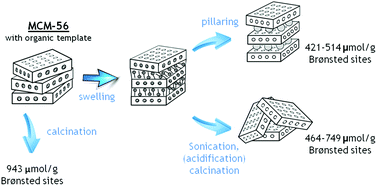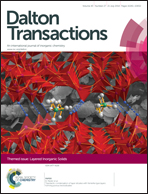High acidity unilamellar zeolite MCM-56 and its pillared and delaminated derivatives†
Abstract
The unilamellar form of zeolite MWW, MCM-56, which is obtained by direct hydrothermal synthesis has been studied with regard to acidity and porosity in its original and post-synthesis modified pillared and delaminated forms. The acidity measured by FTIR was found to be only slightly lower than the highly active 3-D MWW forms, MCM-22 and MCM-49. Pivalonitrile adsorption, which is a measure of spatial openness, showed 50% accessibility vs. <30% for MCM-22/49. It highlights the potential of MCM-56 as a layered material with increased access to acid sites because it does not entail laborious post-synthesis modification. Swelling, pillaring and delamination of MCM-56 are facile but result in a reduction in the number of Brønsted acid sites (BAS) while increasing accessibility to pivalonitrile. The delamination procedure involving sonication and acidification of the highly basic mother liquor produces the most visible increase in surface area and access to all BAS. The accompanying doubling of the solid yield and the decrease in absolute number of BAS suggest significant precipitation of dissolved silica generated during swelling and sonication in high pH medium. The viability of separating surfactant covered layers upon sonication with the consequence of exposing hydrophobic hydrocarbon tails to aqueous environment is addressed.

- This article is part of the themed collection: Layered Inorganic Solids

 Please wait while we load your content...
Please wait while we load your content...